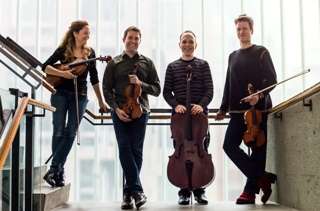|
Back
Haydn and Pal bridge three centuries Ottawa
Dominion-Chalmers United Church
07/30/2015 -
Franz Joseph Haydn: String Quartets No. 35 in F minor, Opus 20, No. 5, & No. 77 in C major (“Emperor”), Opus 76, No. 3
Jordan Pal: String Quartet (world premiere)
St. Lawrence String Quartet: Geoff Nuttall, Owen Dalby (violins), Lesley Robertson (viola), Christopher Costanza (cello)

L. Robertson, O. Dalby, C. Costanza, G. Nuttall
(© Leonardo Mascaro)
This week Ottawa’s Chamberfest has been a banner one for string quartets. Tuesday night’s stunning performance by the Calidore Quartet was a tough act to follow, but Canada’s St. Lawrence Quartet demonstrated its own commanding virtuosity and artistry in a program of Haydn, as well as premiere of a new Quartet by Toronto composer, Jordan Pal. Founded in 1989, The St. Lawrence Quartet presents a broad, open sound and a tremendously solid, absolutely consistent degree of rhythmic unity – the four players perform quite literally as one, something which has not been compromised by fairly recent personnel changes.
Haydn’s Quartet Opus 20, No.5 opened the performance and the first movement’s alternating serious and joyous moods set the tone for the entire evening. The Opus 20 Quartets were composed in 1772, the height of a Sturm und Drang era for German arts, and Haydn is believed to be reacting to a society of debate and controversy – the music is genuinely political. The second movement, Menuetto (with a folkdance trio section), again begins seriously, then becomes humorous, lightened in part by triple time. The more languid third movement, Adagio, is characterized by an exquisite, delicate lilting siciliano and featured a beautifully detailed first violin solo from Geoff Nuttall. The finale, an elaborate fugue, was stunningly realized, a virtuoso tour de force with magnificent work from all four players.
The concert’s first half continued with the premiere of Jordan Pal’s new Quartet, the third new work by this brilliantly imaginative composer heard in Ottawa during the past twelve months. A year ago Canada’s National Youth Orchestra presented Pal’s the afar, a tone poem celebrating the arid beauty of Northeastern Ethiopia, while last May the National Arts Centre Orchestra performed his Triple Concerto, commissioned by The Gryphon Trio and the Thunder Bay Symphony.
Like the Triple Concerto, which had roots in Beethoven’s work of the same name, Pal’s Quartet again is sourced from almost three centuries earlier – in this case, Haydn’s Opus 20 Quartets which, as noted, were reaction to social and political stresses of the later eighteenth century. In a programme note, Pal writes that these particular Haydn Quartets “remind us that music, like the world around it, is forever changing... highlight the impact society can have on shaping compositional techniques and aesthetics” and show “abandonment of the courtly Galante style, in favour of greater levels of dissonance, equality of voices, and innovative structures.”
Accordingly, the four movements of Pal’s Quartet address philosophical issues being faced today – information overload, the environment, burgeoning consumerism, and overpopulation. This might seem trite to some, but the reality is that Pal has produced a work of originality and genuine integrity. Structurally and rhythmically the Quartet is founded on music of the classical era, while the overall dense texture comes across as Brahmsian with sometimes hints of Alban Berg and others who were prominent during the earlier twentieth century.
The opening movement is busy, nervy and often dissonant with its triplets on quarter time. The second movement starts with soft, subtle sounds suggesting wind, birds and nature, though with frequent thoughtful pauses and mournful contemplation fragments alternating with lyrical ones. The third movement is a minuet homage, with jazz elements and polyrhythms. The finale’s incessant zig-zag phrasing leading to a series of declamatory climaxes evokes Beethoven and even some Chopin (finale of the Sonata for piano No. 2 in b-flat Minor).
Overall, Pal’s Quartet is concise, brilliant music and stands up well even without considering the social and political ideology and related lineage which are its basis. And the St. Lawrence Quartet players performed it superbly.
After intermission, it was back to Haydn, this time one of the later quartets, Quartet Opus 76, No. 3 “Emperor”. The opening movement, Allegro is defined by its descending cadence then subsequent figuration over a drone bass – imperial, though with a touch of levity. The second movement is variations on the familiar Austrian National Anthem, “God Protect Emperor Franz”, while the third movement, Menuetto is stately and elegant. The concluding Finale: Presto is defined not by cadence, but rather a repeated chord figuration which launches the primary melody.
Again, the players were in their element. For an encore, it was back to the beginning, with the slow movement from the Quartet Opus 20, No. 1, bringing performers and listeners full circle after a program of stunning and engrossing music.
Charles Pope Jr.
|